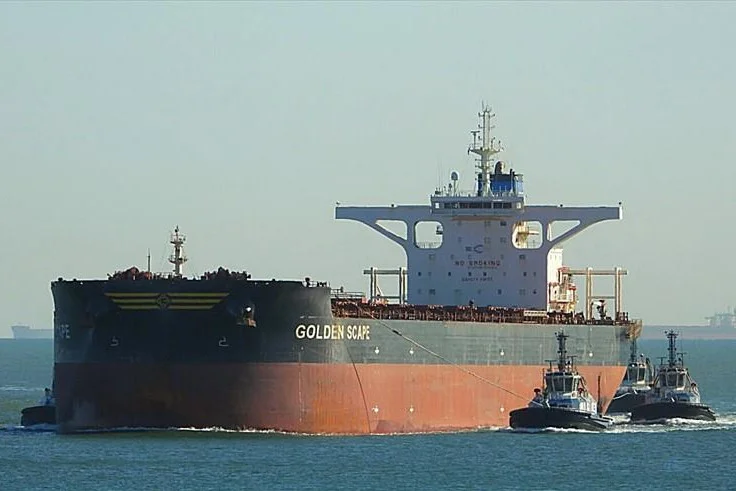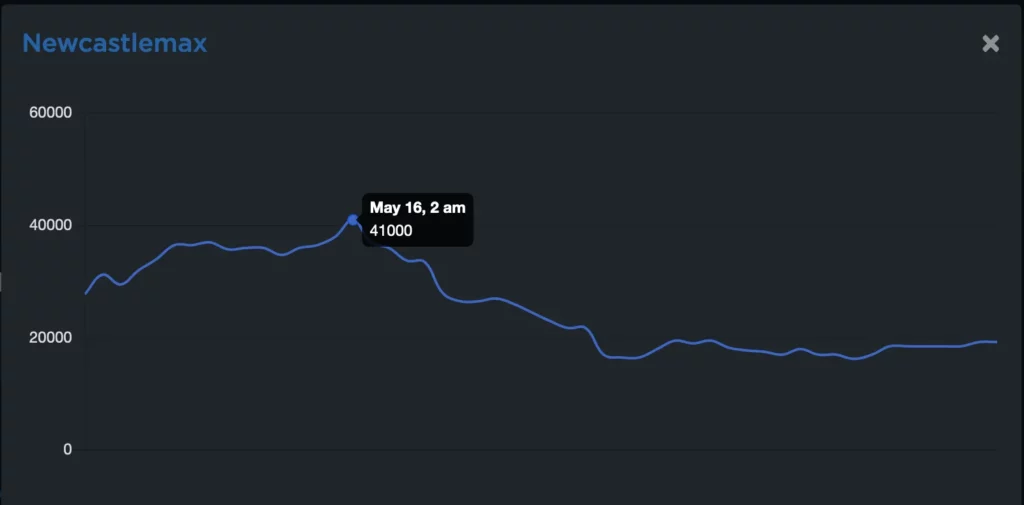The Newcastlemax bulk carrier is a large vessel used to transport bulk cargo such as coal, iron ore, and grain across the world’s oceans. These ships are designed to be able to carry as much cargo as possible to make shipping more efficient and cost-effective.
In this article, we will take a closer look at the history and development of the Newcastlemax, its characteristics and features, its advantages and limitations, and its role in the shipping industry.
The purpose of this article is to provide a comprehensive overview of the Newcastlemax bulk carrier for readers interested in the maritime industry.

History and Development of the Newcastlemax
The bulk carrier industry has a long history, with the first bulk carriers being used in the early 1900s. These early bulk carriers were small and designed to transport specific types of bulk cargo, such as coal and grain. As demand for bulk cargo transportation grew, so did the size of the vessels used to transport it.
The evolution of bulk carrier design has been driven by the need to make shipping more efficient and cost-effective. With the advent of new technologies, bulk carriers have become larger and more capable of carrying a wide range of bulk cargo. The Newcastlemax bulk carrier is a prime example of this evolution.
The Newcastlemax is a new type of bulk carrier that was developed specifically to meet the demands of the iron ore trade in Australia. The ports of the Australian state of New South Wales, particularly the port of Newcastle, have restricted maximum lengths of 300 meters, width of 50 meters, and draft of vessels entering the port. The Newcastlemax was designed to be able to load and unload cargo at these ports.
The Newcastlemax is one of the largest bulk carrier classes in the world, with a deadweight of up to 211,000 metric tons. It is capable of carrying a wide range of bulk cargoes, including coal, iron ore, and grain. Its design allows it to be loaded and unloaded at ports with restricted lengths, widths, and drafts, making it a valuable asset to the shipping industry.
Characteristics and Features of the Newcastlemax
The Newcastlemax bulk carrier is a large vessel, typically measuring up to 300 meters in length and 50 meters in width. It has a deadweight of up to 211,000 metric tons and is capable of carrying a wide range of bulk cargoes such as coal, iron ore, and grain.
It has a special bow design that reduces water resistance, making it more fuel-efficient. Additionally, the Newcastlemax has a larger cargo hold capacity than other bulk carriers of similar size, increasing its overall cargo capacity.
When compared to other bulk carrier designs, the Newcastlemax stands out for its unique features and capabilities. The following table shows a comparison of the main ship particulars of a Newcastlemax and a Capesize and Panamax bulk carrier:
| Parameter | Newcastlemax | Capesize | Panamax |
|---|---|---|---|
| Length (m) | 300 max | 290 – 300 | 200-230 |
| Width (m) | 50 max | 45 – 47,5 m | 32,26 max |
| Deadweight (mt) | 205,000 – 211,000 | 175,000 – 183,000 | 65,000 – 80,000 |
| Number of holds | 9 | 9 | 7 |
| Cargo Hold Capacity (m3) | 215,000 – 225,000 | 185,000 – 200,000 | 70,000 – 90,000 |
| Geared | No | No | No |
| One of the biggest in the class | MV Golden Scape | MV Cape Europe | MV Danae |
These characteristics make it a valuable asset to the shipping industry. The coal trade for this size and class bulk carriers is a major part of their commercial operations. The efficiency of coal transportation largely depends on port restrictions both in loading and discharging ports.
The port of Newcastle in Australia is one of the major export ports in Australia and in 2022 loaded over 136 mln tonnes of coal. In 2021, the figures were even higher and reached 156 mln tons of coal export. To be able to export such a volume of cargo, the loading operations and the fleet calling the port should be very efficient. This led to the appearance of the next bulk carrier class which is just a wider version of the Capesize bulk carrier.
Shipyards planning and building this class of bulk carriers allow shipowners and operators to offer their ships the most efficient loading at Newcastle Port in Australia. Similar to Capesize, Newcastlemax bulk carriers can load 20,000-30,000 mt of coal, which is about 10% of the capacity of this size of bulk carrier.
What is the cost of building Newcastlemax bulk carrier?
The cost to build a Newcastlemax bulk carrier can vary greatly depending on several factors such as the shipyard, the ship’s specifications and equipment, and the current market conditions. According to industry estimates, the cost to build a Newcastlemax bulk carrier can range from $45 million to $70 million or more. However, it’s worth mentioning that this is just an estimation, actual cost may vary.
Meanwhile, secondhand Kamsarmax Ships are valued at $29,5 million for 5-year-olds and at $23 million for 10-year-old vessels. For the latest updates, you can check weekly updates by Fearnleys AS.
What Are Newcastmax Charter Rates?
Time charter (TC) rates have reached their minimum at the beginning of 2023. Freight rates fall to the level of $5-6k in the Pacific and Australia/China region. This is quite common and expected charter rates drop during the New Year season and lunar holidays in particular. Last year January-February rates showed the same performance and were at their minimums below $2K / day.

Time charter rates are currently leveled during the last 6 months. Last week’s rates were $19,500 per day fixing 1-year TC which is about $10,000 – $15,000 lower than time-charter rates peaking in the first half of 2022 reaching 41,000$ for 208,000 DWT dry bulk carriers in May 2022.
The latest known time charter agreement publicly announced with the charter rate was $19,000 by 2020 Bulkers Ltd. for Bulk Sydney – you check their press release.
Advantages and Limitations of the Newcastlemax
The Newcastlemax bulk carrier has several advantages that make it a valuable asset to the shipping industry. One of the main advantages is its ability to be loaded and unloaded at ports with restricted lengths, widths, and drafts. This allows it to access ports that other bulk carriers cannot, increasing its flexibility and versatility.
Another advantage of the Newcastlemax is its large cargo hold capacity, which allows it to carry more cargo than other bulk carriers of similar size. This makes it more efficient and cost-effective for shipping companies. Additionally, its advanced navigation and communication systems provide the ship’s crew with real-time information about the ship’s location, speed, and cargo status, which allows them to better manage the ship’s operations.
However, the Newcastlemax also has some limitations. One of the main limitations is its high operating cost, which is mainly driven by its large size and the need for specialized equipment and technology. Additionally, the Newcastlemax is limited in the number of ports that can accommodate the size and the draft of the vessel, which can be a limitation in terms of route planning.
Overall, the Newcastlemax is a valuable asset to the shipping industry due to its unique design and capabilities. However, it is important for shipping companies to consider the cost and limitations when deciding whether to use a Newcastlemax for their operations.
Newcastlemax in the Shipping Industry
The Newcastlemax bulk carrier plays a crucial role in the shipping industry, particularly in the transportation of bulk cargoes such as coal, iron ore, and grain. Its ability to be loaded and unloaded at ports with restricted lengths, widths, and draft allows it to access ports that other bulk carriers cannot, making it an important tool for shipping companies that need to transport cargo to and from these ports.
The Newcastlemax’s large cargo hold capacity also makes it an efficient and cost-effective option for shipping companies that need to transport large amounts of bulk cargo. Its advanced navigation and communication systems provide the ship’s crew with real-time information about the ship’s location, speed, and cargo status, which allows them to better manage the ship’s operations and ensure that cargo is delivered safely and on time.
The Newcastlemax also plays a role in the global economy by facilitating the movement of bulk cargoes that are essential for industries such as construction, energy, and agriculture. Without the Newcastlemax and other bulk carriers, the transportation of these cargoes would be much more difficult and expensive, which would have a ripple effect on the global economy.
Overall, the Newcastlemax is an important asset to the shipping industry, providing shipping companies with the capability to transport bulk cargoes to and from ports with restrictions of length, width, and draft, and allowing them to transport large amounts of cargo efficiently and cost-effectively.
Conclusion
In conclusion, the Newcastlemax bulk carrier is a unique and valuable asset to the shipping industry. Its ability to be loaded and unloaded at ports with restricted length, width, and draft, and its large cargo hold capacity make it an efficient and cost-effective option for shipping companies that need to transport large amounts of bulk cargo. Additionally, its advanced navigation and communication systems provide the ship’s crew with real-time information about the ship’s location, speed, and cargo status, allowing them to better manage the ship’s operations and ensure that cargo is delivered safely and on time.
However, it’s important to note that the Newcastlemax also has some limitations, mainly the high operating cost which is mainly driven by its large size and the need for specialized equipment and technology. Additionally, the Newcastlemax is limited in the number of ports that can accommodate the size and the draft of the vessel, which can be a limitation in terms of route planning.
Despite these limitations, the Newcastlemax plays a crucial role in the shipping industry, particularly in the transportation of bulk cargoes such as coal, iron ore, and grain, and it’s important for shipping companies to consider the cost and limitations when deciding whether to use a Newcastlemax for their operations. The Newcastlemax class originated in the late 2000s, the design was developed with the goal of creating a bulk carrier that would be capable of accessing ports with restricted length, width, and draft and the first Newcastlemax vessel was built in 2009.
- Types of Gas Carriers as per IGC Code – April 22, 2025
- Wind-Assisted Propulsion Systems (WAPS): A Game Changer for Maritime Decarbonization – February 6, 2025
- 10 Boat Salvage Yards in California – January 25, 2025



